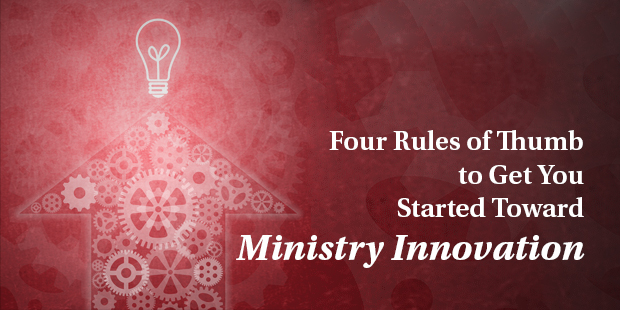
Four Rules of Thumb to Get You Started Toward Ministry Innovation
Solving a difficult ministry challenge requires imagination, focus, endurance, and a tolerance for failure, to name but a few key ingredients. However, the real secret behind delivering world-class ministry innovation actually depends on what we lack rather than what we have.
Here are four memorable little rules of thumb aimed to help guide your decision making as you address ministry and organizational challenges alike.
>> If the schedule gets longer, you’re doing it wrong-er.
It turns out delaying a project’s delivery date in response to difficulty is a demonstrably ineffective problem-solving technique, to say nothing of being inefficient.
>> The more you delay, the more you will pay.
Long timelines expose projects to more changes than short timelines. Technologies change, markets change and economic situations change. Responding to these changes can be expensive, not only in terms of dollars but also in the amount of intellectual investment required.
>> The smaller the crew, the more you can do.
One of the best ways to unleash talent is to not have too much of it. That is, a small team of talented people will generally outperform a larger group of similarly skilled people, because the members of the smaller group have a greater personal investment in the outcome and thus apply their talents more effectively.
>> A simpler design will work just fine.
Generally speaking, complexity is not a sign of sophistication. Simplicity is. Increases to complexity therefore should be approached with caution.
The good news is that you have an alternative. It genuinely is possible to be fast, inexpensive, restrained, and elegant. When you put those pieces together, you just might discover you are capable of producing something amazing.
Author Dan Ward calls this approach the F.I.R.E. method, and it’s the subject of his recent book F.I.R.E.: How Fast, Inexpensive, Restrained and Elegant Methods Ignite Innovation.
F.I.R.E. presents and analyzes a wide range of rapid, thrifty innovation stories, including both successes and failures, and shows how focusing on speed, thrift, simplicity and restraint helps foster creativity.
The foundational lesson is that people who produce breakthrough results often pursue and embrace limited resources and have a low tolerance for complexity.
>> Download a brief manifesto about all of the F.I.R.E. concepts here.

Tags: Dan Ward, F.I.R.E., Innovation, ministry innovation













